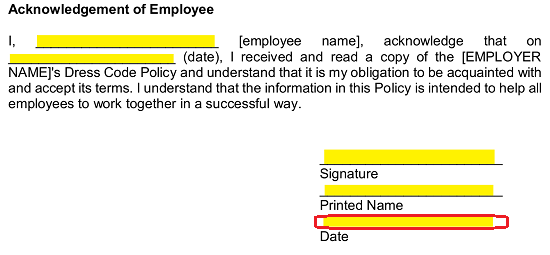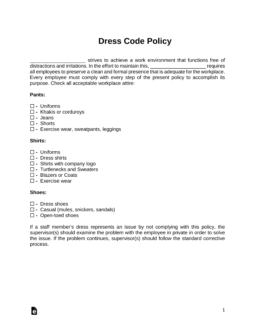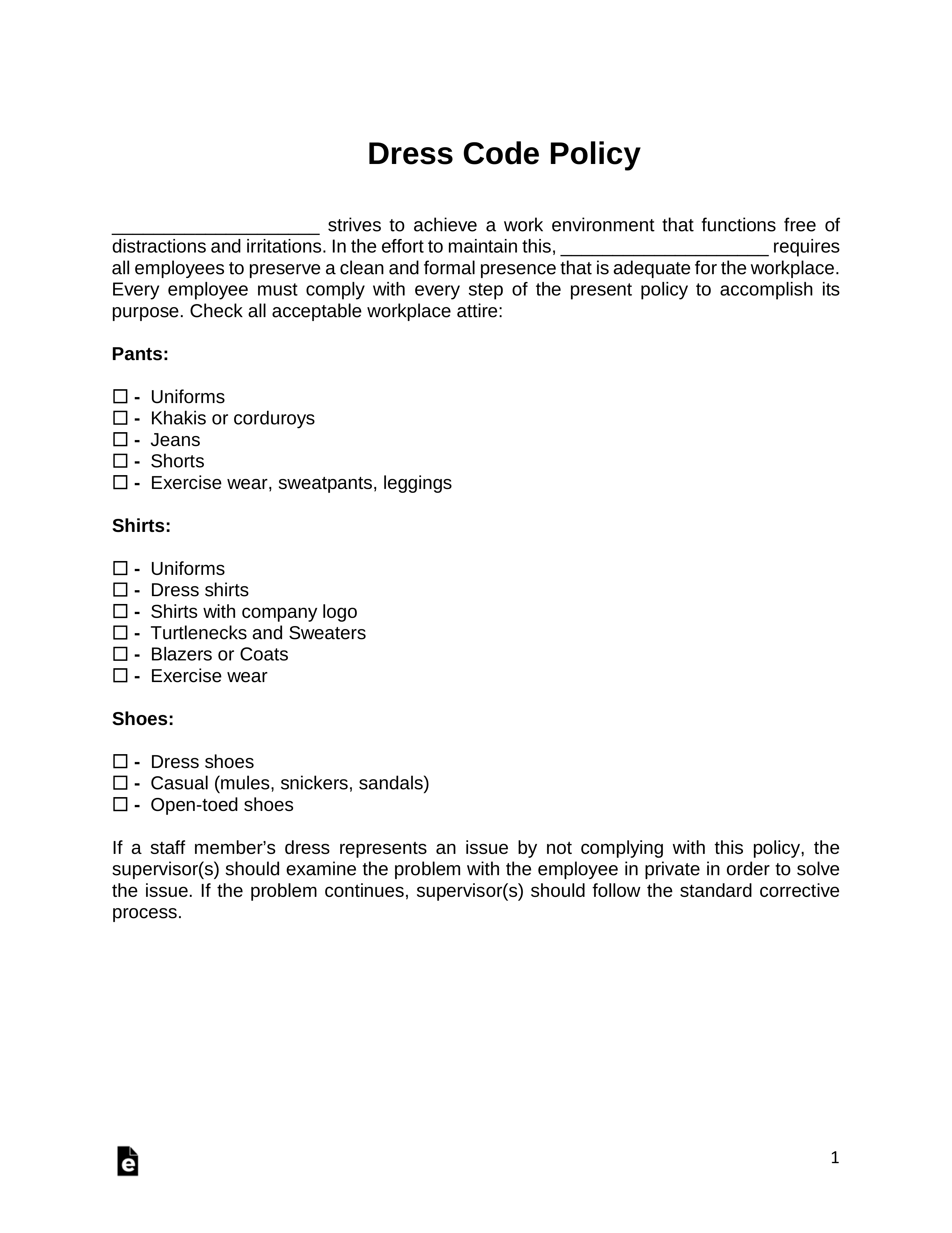Updated July 19, 2023
An employee dress code policy is for any public or private institution that wants to implement a uniform appearance for all the individuals of the organization. There are usually two types of uniform policies where the members of the company (1) must wear specific garb (shirt and pants) or (2) formal wear such as a suit and tie for men and a skirt or equivalent for women. Dress code policies typically depend on the type of company and industry standards.
Video
How to Write
1 – Gain Access To The Policy Template Using The Buttons Displayed Here
Three different file versions (PDF, Microsoft Word (.docx), Open Document Text (.odt)) of the paperwork required to issue a notice informing employees of a Company’s Dress Code have been included on this page as a matter of convenience. If you have software compatible with any of these files you may download that file format by selecting the appropriately named button in the caption area of the preview picture.
2 – Prepare This Notice By Providing All The Required Information
The opening declarative statement of this Notice is composed of the language required to obligate an Employee to the Employer’s Dress Code. Since this paragraph can be applied to a variety of Employer/Employee contracts or agreements, it will need the exact Name of the entity using it. Furnish the Legal Name of the Entity issuing this Notice on the blank space before the words “…Strives To Achieve A Work Environment” then, again, on the blank line after the phrase “In The Effort To Maintain This” and the words “Requires All Employees…” Make sure the Business Entity’s Name appears the same on both lines. 
3 – Outline The Desired Apparel The Employer Expects The Recipient To Wear When Working
The way the Company or Business Entity wishes the Employee to dress will also have to be presented in a clear manner. This can be handled nicely with a few checklists. The next area of this Notice will supply three such lists. Here the Employer must check off each list item that is considered acceptable as “Workplace Attire.”
The first checklist, titled “Pants,” will enable the Employer to select what manner of legwear the Employee can wear in the workplace. Mark each list item allowed to the Employee. If a list item here is not marked, the Employee will not be allowed to wear the unmarked items. For instance, if the Employee may only wear a Uniform, then mark the checkbox labeled “Uniforms” and leave the others blank. Mark the checkbox corresponding to each list item (“Uniforms, Khakis Or Corduroys,” “Jeans,” “Shorts,” and “Exercise Wear, Sweatpants, Leggings”) the Employee may wear. 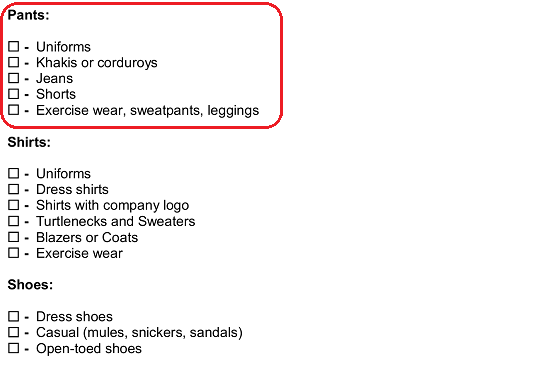 Next, we will address the list labeled “Shirts.” Here, the Employer is presented with a list composed of various tops an Employee is permitted to wear to the workplace. Mark each choice the Employer will afford the Employee from the options presented (“Uniforms, “Dress Shirts,” “Shirts With Company Logo,” “Turtlenecks And Sweater,” “Blazers Or Coats,” and “Exercise Wear”). As with the previous list, each item whose checkbox has been marked will be considered a permissible top by the Employer, while each unmarked item will not. Thus, if Uniforms are optional and the Employer only wishes to forbid “Exercise Wear” then only leave “Exercise Wear” unmarked.
Next, we will address the list labeled “Shirts.” Here, the Employer is presented with a list composed of various tops an Employee is permitted to wear to the workplace. Mark each choice the Employer will afford the Employee from the options presented (“Uniforms, “Dress Shirts,” “Shirts With Company Logo,” “Turtlenecks And Sweater,” “Blazers Or Coats,” and “Exercise Wear”). As with the previous list, each item whose checkbox has been marked will be considered a permissible top by the Employer, while each unmarked item will not. Thus, if Uniforms are optional and the Employer only wishes to forbid “Exercise Wear” then only leave “Exercise Wear” unmarked.  The final list to attend to is titled “Shoes,” and will give the Employer the opportunity to define what type of footwear will be allowed in the workplace. Here, the Employer may define if the Employee can wear “Dress Shoes,” “Casual (Mules, Snickers, Sandals),” and/or “Open-Toed Shoes” by marking the checkbox corresponding to the permissible workplace footwear.
The final list to attend to is titled “Shoes,” and will give the Employer the opportunity to define what type of footwear will be allowed in the workplace. Here, the Employer may define if the Employee can wear “Dress Shoes,” “Casual (Mules, Snickers, Sandals),” and/or “Open-Toed Shoes” by marking the checkbox corresponding to the permissible workplace footwear. 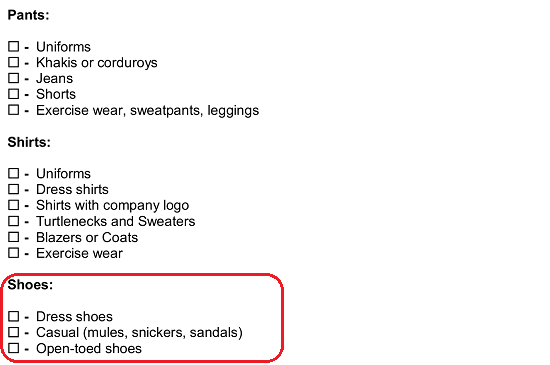
4 – This Notice May Only Be Considered Valid With The Employee Signature
This paperwork must be presented to and signed by the Recipient Employee to be considered delivered, read, and comprehended by the Employee. The signing will occur in the “Acknowledgement Of Employee” section. Make sure the statement under this heading is supplied with the Full Name of the Employee on the blank space labeled “Employee Name” and the Date of Receipt on the blank space labeled “Date.” This paragraph must be filled out before the Employee signs it. It may be filled out by the Employer or the Employee but only the Employee may satisfy the next area. 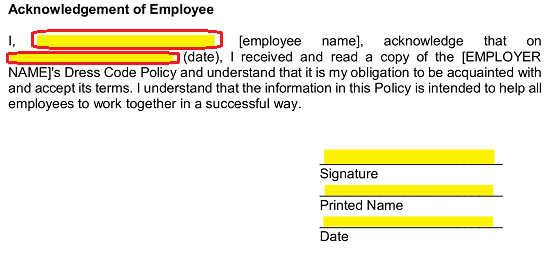 The Employee must be given ample time to read this document in full. Once he or she has completed this task, the “Signature” line will need to be signed by the Employee as proof of receipt and agreement.
The Employee must be given ample time to read this document in full. Once he or she has completed this task, the “Signature” line will need to be signed by the Employee as proof of receipt and agreement. 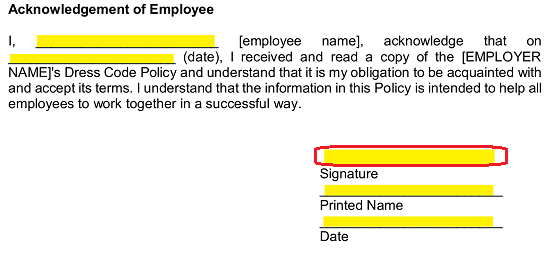 The Employee prints his or her Name on the line supplied under the signature.
The Employee prints his or her Name on the line supplied under the signature.  Finally, the Employee should record the current Calendar Date when he or she signs this Notice on the line labeled “Date.”
Finally, the Employee should record the current Calendar Date when he or she signs this Notice on the line labeled “Date.” 